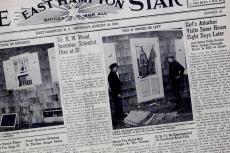The East Hampton Town Board and residents are angry and dismayed by the State Department of Environmental Conservation’s March 30 issuance of a modified permit that allows an East Hampton mining company to expand a pit, dig to a depth of 110 feet below the groundwater table, and create a 6.05-acre pond, in order to continue mining sand and gravel there.
At Sand Highway L.L.C. on Middle Highway, which is owned by Patrick Bistrian Jr., the D.E.C. “conducted a technical review of the proposal and added conditions to the modified permit to protect environmental resources and ensure public safety,” according to a statement provided by the department this week.
The pond — now a meadow — is to have vegetated, sloped shorelines within the permitted 11.6-acre mine area. The modified permit does not allow horizontal expansion of the mine site, an increase in the rate of extraction, or the importation of offsite material.
Sand Highway, a designated pre-existing, nonconforming facility under town code, at present is sampling groundwater biannually. With the modified permit, the D.E.C. requires quarterly samples of six onsite monitoring wells when mining reaches groundwater. Samples are to be analyzed by a certified laboratory for total and dissolved metals and volatile and semivolatile organic compounds. The results must be provided to the D.E.C. for evaluation.
Residents, the town board, the Suffolk County Water Authority, Assemblyman Fred W. Thiele Jr., and conservation groups had all come out against the expansion. Last year, Nancy LaGarenne, a nearby neighbor of the site, called on town officials to sue Sand Highway and Mr. Bistrian to stop the proposal, fearing contamination of drinking water. The town board made its opposition known in letters to the D.E.C. An expansion “would not only be an environmental cataclysmic intrusion into the water table that serves as a sole-source aquifer for the entire South Fork,” one read, “but is patently prohibited by the zoning code of the Town of East Hampton and thus such application must be denied by the D.E.C.” The D.E.C. accepted public comment through Sept. 27 of last year.
Jeffrey W. Szabo, chief executive officer of the water authority, said in a letter to the D.E.C. last year that sand, gravel, and clay make up a natural form of pollution prevention and filtering of groundwater and drinking water. “When materials that make up this barrier are removed, the protection of the aquifer is reduced or lost altogether,” he wrote.
Ms. LaGarenne called in to the town board’s remote meeting last Thursday, calling it “unbelievable that the D.E.C. railroaded that permit in for the sand mine during this pandemic.”
Supervisor Peter Van Scoyoc responded that board members had just learned of the issuance of the modified permit, and had not been notified directly by the D.E.C. “I was very surprised to learn that the permit had been issued,” he said, noting “very strong objections by the town. We will continue to follow up on that issue.” Town attorneys are discussing a possible course of action, another official said, but, as those discussions may relate to pending litigation, board members would not comment further.
The D.E.C. will inspect the facility and review testing results to ensure public safety and environmental protection, according to its statement.
Mr. Bistrian had not returned a call seeking comment at press time.



